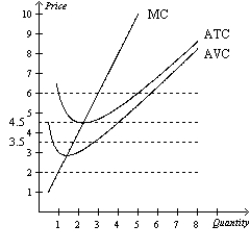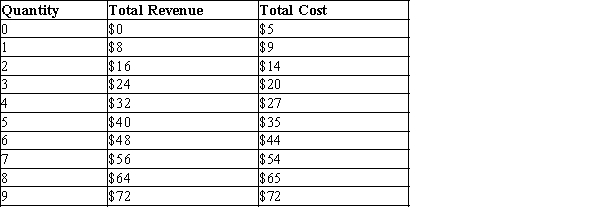A) less than $2.50
B) more than $2.50
C) exactly $2.50
D) The marginal revenue cannot be determined without knowing the actual quantity sold by the typical firm.
F) B) and C)
Correct Answer

verified
Correct Answer
verified
True/False
The short-run supply curve in a competitive market must be more elastic than the long-run supply curve.
B) False
Correct Answer

verified
Correct Answer
verified
Multiple Choice
In the long run the market supply
A) must always be horizontal.
B) could be upward sloping if the cost of production falls as new firms enter the market.
C) could be upward sloping if the cost of production rises as new firms enter the market.
D) could be upward sloping if technological improvements lower the cost of producing in the market.
F) A) and B)
Correct Answer

verified
Correct Answer
verified
Short Answer
A competitive firm sells 100 units of output for $5 per unit. The firm's marginal revenue amounts to __________.
Correct Answer

verified
Correct Answer
verified
Multiple Choice
Figure 14-13
Suppose a firm in a competitive industry has the following cost curves:  -Refer to Figure 14-13. If the price is $6 in the short run, what will happen in the long run?
-Refer to Figure 14-13. If the price is $6 in the short run, what will happen in the long run?
A) Nothing. The price is consistent with zero economic profits, so there is no incentive for firms to enter or exit the industry.
B) Individual firms will earn positive economic profits in the short run, which will entice other firms to enter the industry.
C) Individual firms will earn negative economic profits in the short run, which will cause some firms to exit the industry.
D) Because the price is below the firm's average variable costs, the firms will shut down.
F) All of the above
Correct Answer

verified
Correct Answer
verified
Multiple Choice
Table 14-16
The table represents the demand information for a firm in a competitive market. 
-Refer to Table 14-16. For this firm, when output is equal to 12 units, average revenue is
-Refer to Table 14-16. For this firm, when output is equal to 12 units, average revenue is
A) $15.
B) $150.
C) always greater than marginal revenue.
D) decreasing.
F) A) and D)
Correct Answer

verified
Correct Answer
verified
True/False
In the short run, a firm should exit the industry if its marginal cost exceeds its marginal revenue.
B) False
Correct Answer

verified
Correct Answer
verified
Multiple Choice
The exit of existing firms from a competitive market will
A) increase market supply and increase market price.
B) increase market supply and decrease market price.
C) decrease market supply and increase market price.
D) decrease market supply and decrease market price.
F) A) and C)
Correct Answer

verified
Correct Answer
verified
Multiple Choice
A competitive firm has been selling its output for $20 per unit and has been maximizing its profit, which is positive. Then, the price rises to $25, and the firm makes whatever adjustments are necessary to maximize its profit at the now-higher price. Once the firm has adjusted, its
A) quantity of output is higher than it was previously.
B) average total cost is higher than it was previously.
C) marginal revenue is higher than it was previously.
D) All of the above are correct.
F) All of the above
Correct Answer

verified
Correct Answer
verified
Multiple Choice
When a profit-maximizing firm in a competitive market has zero economic profit, accounting profit
A) is negative.
B) is at least zero.
C) is also zero.
D) could be positive, negative or zero.
F) A) and C)
Correct Answer

verified
Correct Answer
verified
Multiple Choice
Table 14-9
Suppose that a firm in a competitive market faces the following revenues and costs:  -Refer to Table 14-9. In order to maximize profit, the firm will produce a level of output where marginal cost is equal to
-Refer to Table 14-9. In order to maximize profit, the firm will produce a level of output where marginal cost is equal to
A) $6.
B) $7.
C) $8.
D) $9.
F) A) and C)
Correct Answer

verified
Correct Answer
verified
True/False
A firm operating in a perfectly competitive industry will shut down in the short run but earn losses if the market price is less than that firm's average variable cost.
B) False
Correct Answer

verified
Correct Answer
verified
True/False
For a firm operating in a perfectly competitive industry, total revenue, marginal revenue, and average revenue are all equal.
B) False
Correct Answer

verified
Correct Answer
verified
True/False
If some resources used in the production of a good are only available in limited quantities, then the long run market supply curve will be perfectly elastic.
B) False
Correct Answer

verified
Correct Answer
verified
Multiple Choice
A competitive firm has been selling its output for $20 per unit and has been maximizing its profit, which is positive. Then, the price falls to $18, and the firm makes whatever adjustments are necessary to maximize its profit at the now-lower price. Once the firm has adjusted, its
A) quantity of output is lower than it was previously.
B) average total cost is lower than it was previously.
C) marginal cost is higher than it was previously.
D) All of the above are correct.
F) All of the above
Correct Answer

verified
Correct Answer
verified
Multiple Choice
When a profit-maximizing firm's fixed costs are considered sunk in the short run, then the firm
A) can set price above marginal cost.
B) must set price below average total cost.
C) will never show losses.
D) can safely ignore fixed costs when deciding how much output to produce.
F) A) and C)
Correct Answer

verified
Correct Answer
verified
Multiple Choice
In a market with a fixed number of firms, as long as price is above average
A) variable cost, each firm's marginal-cost curve is its supply curve.
B) variable cost, each firm's average-total-cost curve is its supply curve.
C) total cost, each firm's marginal-cost curve is its supply curve.
D) total cost, each firm's average-total-cost curve is its supply curve.
F) C) and D)
Correct Answer

verified
Correct Answer
verified
Multiple Choice
Table 14-10
Suppose that a firm in a competitive market faces the following revenues and costs:  -Refer to Table 14-10. This firm should continue to produce and sell units as long as the marginal cost of production is less than or equal to
-Refer to Table 14-10. This firm should continue to produce and sell units as long as the marginal cost of production is less than or equal to
A) $3.
B) $5.
C) $7.
D) $9.
F) None of the above
Correct Answer

verified
Correct Answer
verified
True/False
When an individual firm in a competitive market decreases its production, it is likely that the market price will rise.
B) False
Correct Answer

verified
Correct Answer
verified
Multiple Choice
When new firms enter a perfectly competitive market,
A) economic profits of existing firms will continue to be zero.
B) entering firms will earn zero economic profit upon entry into the market.
C) existing firms may see their costs rise if more firms compete for limited resources.
D) prices will rise as existing firms raise prices to keep new firms out of the market.
F) A) and C)
Correct Answer

verified
Correct Answer
verified
Showing 361 - 380 of 608
Related Exams